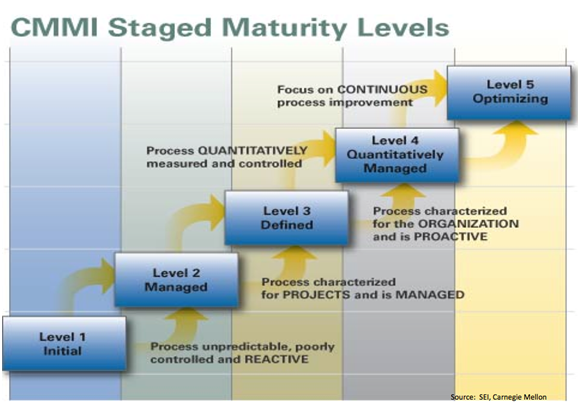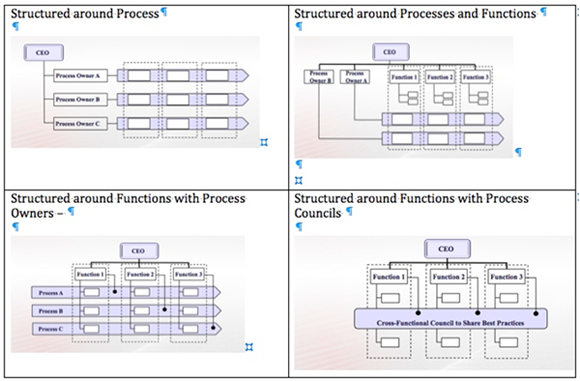Gartner’s definition of BPM is “a management practice that provides for governance of a business’s process environment toward the goal of improving agility and operational performance.“
The definition implies that BPM has both management and leadership and I agree. I would clarify further: leadership of the environment and management of the practices. Let’s see how they both play out by looking at the What, Who, When, and Where of Process Governance.
WHAT are the elements of Process Governance?
There are two important streams to governance:
Leadership includes:
- Accountability and Decision Making
- Vision and strategy
- Process Prioritization
- Regular Monitoring
Management includes:
- Practices – consistent definition and use of one methodology, process roles, training, measures, and frameworks. Here we are talking about selecting and using consistent practices across the company.
- Standards – software tools for modeling and/or execution, vendors, process assets (what components do we create, document, track and keep in the repository), diagramming notation (and maybe a few others)
WHO
Leadership:
There are several leadership process improvement roles:
- Executive Sponsor, Process Owner (most likely from the Business but some organizations have a Business and IT Process Owner for a single process) and;
- Project Lead (for each process improvement project).
There may also be a C-Suite Process Steering Committee or Advisory Committee. If the leadership is not formalized at the enterprise level it might be dispersed throughout the organization in different lines of business and within IT. From my experience, it is critical that Leadership not be exclusively within IT; the best practice is to have leadership at several levels– at the C-Suite, from the business for each process, and within IT as a partner to the business.
Management
The Who in this category are the managers who are BPM Professionals who maintain the standards and practices, often in a BPM Support organization or a Center of Excellence. It is also possible that external consultants might provide the WHO in this arena because of their particular expertise.
WHEN
Leadership:
The question here is when should BPM Leadership be established. There are several ways to look at this:
- Which approach is best for your organization? – Which is Best For Us? Top Down, Bottoms Up or Middle Out? I have another article on BPMInstitute.org about that. My preference is for Middle Out, but there are advantages and disadvantages to each method which are explained in the article.
-
Consider where your organization is on the Process Maturity framework:

- Level 1 – Leadership will be executives, managers, and heroes of initiatives. Process is not formalized yet.
- Level 2- Executive Sponsors, Process Owners, and Project Leads need to be established for each BPM project. These will probably be within lines or business or particular functions.
- Level 3- Here is when leadership needs to be established for the enterprise, which would still be the same roles of Executive Sponsors, Process Owners, and Project Leads listed above in the WHO section. The processes would be larger, more complex, and cross-functional. It is also helpful to have a BPM Professional Group with a Process Director at its head at this stage and a C-Suite Steering Committee looking across the enterprise. Process Owners would be active in new projects and in monitoring processes in an ongoing way.
- Level 4 – Leaders would be called upon to monitor processes, report on them regularly, and prioritize process projects based on metrics and enterprise strategy.
- Level 5 – At this stage the organization has a process driven culture, which means Process Owners have a clear position and accountability in the org chart.
Management:
Again the five Process Maturity Levels provide guidance on when certain practices and standards should be started and incorporated in the organization:
- Level 1 – Processes are ad hoc and informal. No common practices and standards have been developed except maybe in some of the regulatory, finance, or human resource areas such as for the Balance Sheet
- Level 2 – and Profit and Loss Statement, Payroll, or annual sign up for Employee Benefits.
Definition of roles in a BPM Project, selection of a standard process modeling tool, and usage of a consistent BPM methodology are important practices. Training for teams and leaders which provide necessary skills for a BPM project should be available in conjunction with each new BPM project. - Level 3 – Now the organization should have a standard BPM methodology, which includes a charter and specific metrics to gather, and capable teams. At this stage the need for a Shared Repository becomes apparent, and the organization needs to determine which assets to include in the repository. It is time to consider a BPM suite for the organization.
- Level 4 – The practice here is to use consistent practices and standards across the organization. There should be a practice of regular reviews; often processes have nested accountability from individual processes up to the line of business ending at the C-Suite Steering Team.
- Level 5 – The practice here might extend to including customers and suppliers in the process culture per process. Also technology would enable processes to be monitored and changed real time.
WHERE
Leadership:
Where means where in the organizational structure do the leaders reside? There are four different models I find useful to distinguish where leaders might reside.

Source: Process Ownership: The Overlooked Driver of Sustained BPR Success, by Gary Neilson and Vinay Coulo, Booz Allen Hamilton, 2004
The Structured around Process model has the whole company built around processes, so Process Owners report directly to the CEO. In this model Process Owners have full accountability for their process from product management to revenue, budget, employee management and performance evaluation. This model is the most advanced process centric culture.
The Structured around Process and Functions model has both process and functions reporting to the CEO. Employees report in one of the two areas and there are employees within each process who have functional expertise. Here Processes and Functions have ‘equal status’ organizationally. Notice there are no lines of business. So if a core process is order to cash it might have different customer segmentation by type or size of customer.
The Structured around Functions with Process Owner model is the closest to most organizations, particularly at level 2 and 3 process maturity. Here Process Owners have two jobs – to be a Process Owner for a process that is cross- functional and to do the specific work of their own function.
The Structured Around Function with Process Councils has a functional organization again and is using Process Councils to lead the process effort. This is the most informal form of leadership. I do not see this organizational structure very often. It could occur from a grass roots effort where the council might be more a community of practice. I know of one organization that had many Process Councils (not just for process) but they found the Councils cumbersome, with no clear authority, and they were eventually disbanded.
The organization might be different depending on organizational Process Maturity. You might expect the organization structure to move from the bottom two models up to the top two models with increasing Process Maturity, but that has not been my experience. Rather I have seen organizations build their process culture more around adopting consistent standards and practices.
Management:
Standards and consistent practices need to be proposed, established, housed and monitored somewhere with the organization. Here are three places where that might be:
- In a BPM Professional Group (or Center or Excellence) which is centralized and could report to Corporate or IT. This would probably be a fulltime job for these employees.
- Dispersed within different lines of business and coming together as a formal group periodically or just collaborating globally and sharing ideas and best practices. These employees would have this role documented in their job description and part of the performance review. The role should be an important percentage of their job, although it might not be 100%.
- A Community of Practice where individuals perform process activities as a part of their job, and participate in this special interest group to share experiences.
Governance has two important aspects – Leadership (the people and their roles in Process Management and process projects) and the management of standards and practices. Both are important. Both need to be established at Level 2, but there is flexibility in how each organization proceeds. Evaluating how the organization is doing at exhibiting leadership behaviors and standard practices is one method of seeing if the organization is becoming more process mature.

















